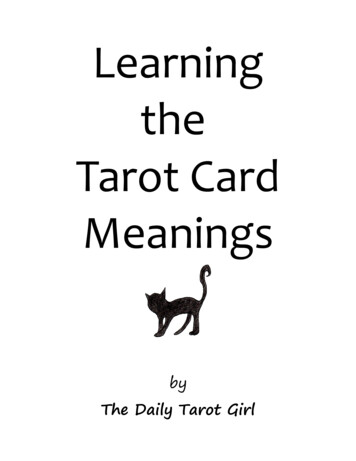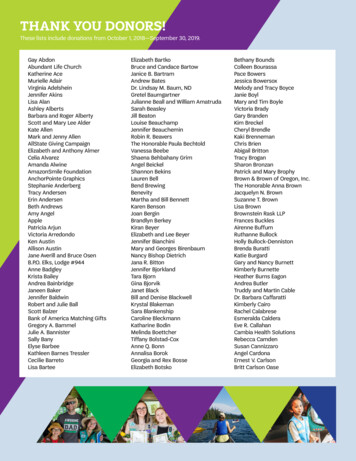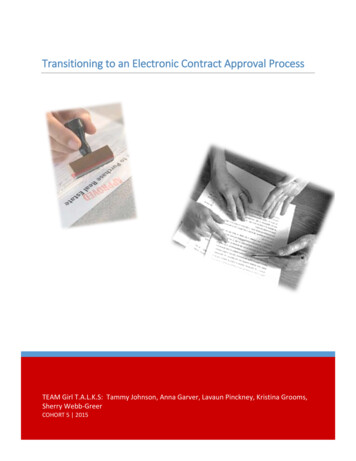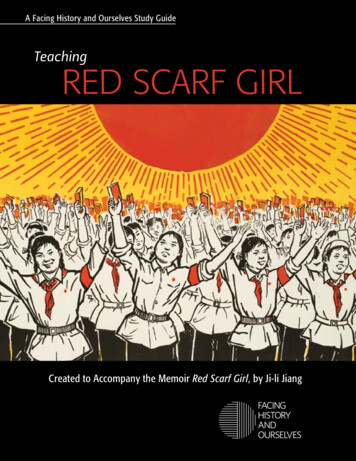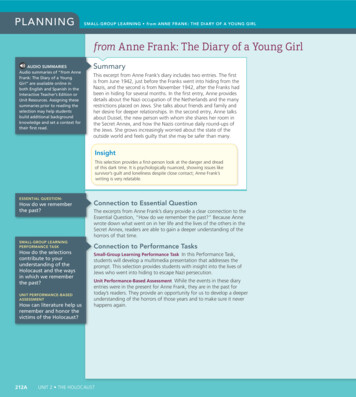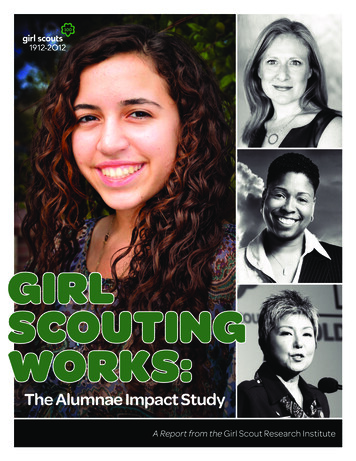
Transcription
The Alumnae Impact StudyA Report from the Girl Scout Research Institute
2012 by Girl Scouts of the USAAll rights reserved.
The Alumnae Impact Study
AcknowledgementsNational PresidentConducted in conjunction withAcknowledgement is made to theConnie L. LindseyFluent, a public opinion and marketfollowing individuals who providedresearch company.expert feedback on the study: SuzanneChief Executive OfficerAnna Maria ChávezBeck, former executive director, NationalThe Girl Scout Research InstituteCoalition of Girls’ Schools; Keoki Hansen,thanks the CEOs and other staffdirector, research and evaluation,Chief of External Affairsfrom the following councils forBig Brothers Big Sisters of America;Timothy Higdontheir contributions to the study:and Susan Lennon, president,Girl Scout Council of the Nation’s CapitalWomen’s College Coalition.Vice President, Research,Girl Scouts of California’s Central CoastGirl Scout Research InstituteGirl Scouts of Greater ChicagoMichael Conn, PhDand Northwest IndianaThe Girl Scout Research Institutethanks the following individuals atGirl Scouts of Greater IowaGSUSA for their contributions to thisAuthors, Girl ScoutGirl Scouts of Greater Mississippi, Inc.study: senior researcher Kallen Tsikalas,Research InstituteGirl Scouts Heart of the Hudson, Inc.editors Kristen Elde and Lynn Obee,Judy Schoenberg, EdMGirl Scouts of NYPENN Pathways, Inc.and designer Julita Ehle.Kimberlee Salmond, MPPGirl Scouts of Northeastern New York, Inc.Kamla Modi, PhDGirl Scouts of Northern CaliforniaThe Girl Scout Research InstituteGirl Scouts of Northern Illinoisexpresses special appreciation to theGirl Scouts of San Gorgonio Councilwomen who participated in this study.Girl Scouts of South Carolina-Mountainsto Midlands, Inc.Girl Scouts of Southeast Florida, Inc.Girl Scouts of Southwest TexasGirl Scouts of Texas Oklahoma Plains, IncGirl Scouts of Western OhioGirl Scouts of Greater IowaGirl Scouts of Western WashingtonFront cover, right middle photo: JurgenReisch of Jurgen Reisch Photography
Contents467811Introduction and BackgroundResearch GoalsKey FindingsAlumnae FactsImpact of Girl Scouting: Comparison of Alumnaeto Non-Alumnae25 Alumnae Evaluation of the Girl Scout Experience37 Significance and Implications of This Study39 Appendix41 Resources3
Introductionand BackgroundGirl Scouts is the world’s most success-gain experience working as part of aful organization dedicated to creating girlteam and, often, as leaders. Girls areleaders, with 3.2 million active membersexposed to a diversity of people, ideas,and more than 59 million alumnae. Sinceand environments. All of this is trueits inception in 1912, women have exploredacross generations of women, as it isnew fields of knowledge, learned valuablefor girls today.1skills, and developed strong core valuesthrough Girl Scouting. The Girl ScoutIn 2005, GSUSA renewed its commit-organization has shaped the lives of thement to girls’ leadership developmentmajority of female senior executives andas a core focus of our mission to buildbusiness owners, two-thirds of womengirls of courage, confidence, andin Congress, and virtually every femalecharacter, who make the world a betterastronaut. The Girl Scout Cookie Programplace, through the development of anis the world’s largest business and finan-enhanced Girl Scout Leadership Experi-cial literacy program for girls, generatingence tied to national outcomes for girls.revenues of 760 million last year.Girls can discover their talents whiletaking on challenging goals; connect withGirl Scouts has built its success onothers in a team environment, acquiringa deep commitment to timeless valuesconflict-resolution and relationship-and building girls of courage, confidence,building skills; and take action to makeand character, who make the worldthe world a better place.a better place. Girl Scouts’ core principleof diversity is inspired by Juliette GordonFurther, Girl Scouts of the USA is usingLow’s commitment to welcoming girlsthe occasion of its 100th anniversaryfrom across all races and classes. Womento declare 2012 the Year of the Girl andwho have been involved in Girl Scoutinglaunch ToGetHerThere: the largest,routinely point to the immediateboldest advocacy and fundraising causebenefits as well as the lasting effectscampaign dedicated to girls’ leadershipof the experience. In Girl Scouts, girlsissues in the nation’s history. This multi-learn practical skills, gain self-knowledgeyear effort will help break down societaland self-confidence, make friends, andbarriers that hinder girls from leading and14In this study, “Girl Scout alumnae” refers to women who participated in Girl Scouting as girls.Girl Scouting Works: The Alumnae Impact Study
achieving success in everything fromtechnology and science to business andindustry. Our long-term goal is ambitiousand urgent: to create balanced leadership in one generation.To do that, we must ask all adultmembers of society—mothers, fathers,corporations, governments, and nonprofits—to help girls reach their leadership potential and place this urgent issuefront and center on the national agenda.We all have a role to play in helping girlsachieve their full leadership potential,because when girls succeed, so doessociety. For more information on Yearof the Girl and ToGetHerThere, includinghow you can join the cause, check outwww.girlscouts.org/yearofthegirl.5
Research GoalsGirl Scouts of the USA celebrates its What are the perceptions ofcentennial in 2012. As the organizationGirl Scout alumnae of the impactlooks ahead to the next 100 years, it is theand benefits of their Girl Scoutideal time for an in-depth exploration ofexperience?the effects of Girl Scouting on alumnaeof multiple generations. This study wasTo examine these questions, the studydesigned to explore questions such as:employed a combination of qualitativeand quantitative methodologies, includ- Does Girl Scout participation resultin positive life outcomes? What are the benefits of the GirlScout experience? Does Girl Scout participationinterviews, an online community, onlinechats, a national random-digit dial (RDD)telephone survey, a mobile phone survey,and an online survey. In total, more thanbenefit certain demographic groups3,750 women participated in this study,more than others? How lasting isof whom roughly 2,000 were Girl Scoutthe impact of Girl Scouting?alumnae. This document presents an How do Girl Scout alumnaeintegrated report of findings from thecompare to non-Girl Scoutqualitative and quantitative phasesalumnae with respect to severalof this study. For more details on thekey indicators of success, includingmethodology and data analysis, pleasesense of self, achievement, leader-refer to the Appendix on page 39.ship, community involvement,commitment to social causes/philanthropy, and civic engagement,among others? To what experiences from childhoodand adolescence do Girl Scoutalumnae and non-alumnae attributetheir success?6ing focus groups, in-depth individualGirl Scouting Works: The Alumnae Impact Study
Key FindingsGirl Scout Alumnaeyears. Alumnae with more than threeof and experiences in Girl Scouts.years’ experience in Girl Scouts fareFun, friendships, and crafts areOne in every two adult women has atbetter than shorter-term alumnae withthe most frequently cited positivesome point been a member of Girl Scouts,regard to:aspects of Girl Scouting.and the average length of time spent in Say they have received concreteGirl Scouts is four years. There are Sense of selfbenefits from Girl Scouting, such ascurrently 59 million Girl Scout alumnae. Civic engagementbeing exposed to nature and having Educationa safe place to try new things.The Girl Scout Research Institute Income/socioeconomic status Actively recognize the impact thatconducted a large-scale mixed-methods Satisfaction with lifeGirl Scouting has had on their lives.research study in conjunction with an SuccessThree-quarters of alumnae reportindependent research firm and reached Leadershipthat the Girl Scout experience hadthe following conclusion: Relationship satisfactiona positive impact on their livesin general.Girl Scouting works.Girl Scouting and PositiveLife OutcomesAll alumnae, even those with two years’experience or less, are more active inThe positive effects of Girl Scoutingcommunity service and volunteer workseem to be particularly pronounced forthan non-alumnae.those women who stayed Girl Scoutslonger, as well as for African AmericanGirl Scout alumnae display positive lifeoutcomes to a greater degree than non-Girl Scouting:A Rewarding ExperienceReconnecting with Girl Scoutsalumnae on several indicators of success,including:and Hispanic women.In addition, Girl Scout alumnae rate theirexperiences highly. Alumnae considerLastly, regarding Girl Scout involvement Sense of selfGirl Scouting to have been positive andlater in life, nearly one in five alumnae Volunteerism and community workrewarding. Women who have been a(19%) has already reconnected with Civic engagementGirl Scout:Girl Scouts as a volunteer or troop leader, Education Income/socioeconomic statusand 21 percent express strong interest Rate their Girl Scout experiences veryhighly. The average rating score fromThese differences are pronounced forwomen who were in Girl Scouts for morein reconnecting with Girl Scouts inthe future.1 to 10 across all alumnae is 8.04. Fondly remember positive aspects7
Alumnae FactsIncidence Rate(36%). In fact, from its high among 55- to64-year-olds, the proportion of Girl ScoutThis study indicates that nearly one inalumnae steadily decreases with eachtwo adult women in the U.S. has at someage cohort. In terms of race, incidencepoint been a member of Girl Scouts.is highest among Caucasians (56%) andThe incidence of Girl Scout alumnae inconsiderably lower among African Ameri-the general population of women agescans (38%), Hispanics (33%), and Asians18 and older is 49 percent. According to(27%). Girl Scouts currently has severalthe most recent (2010) U.S. governmentinitiatives underway to ensure that all girlsestimates, the total population of femaleshave access to and can benefit from theages 18 and older in the U.S. is approxi-organization’s program.mately 120 million. Thus, the community2of Girl Scout alumnae numbers roughlyLength of Membership59 million.Alumnae’s average length of Girl Scout28The incidence of Girl Scout alumnae isparticipation has remained steady acrosshighest among 55- to 64-year-olds (57%)generations and races/ethnicities—aboutand lowest among 18- to 24-year-oldsfour years.2010 Census Data. U.S. Census Bureau. www.census.govGirl Scouting Works: The Alumnae Impact Study
Incidence of Girl Scout alumnae in the general population of women, by age18-2436%25-3445%35-4448%45-5452%55-6465 57%47%Incidence of Girl Scout alumnae in the general population of women, by raceCaucasian56%African American38%HispanicAsian33%27%9
Jurgen Reisch of Jurgen Reisch Photography10Girl Scouting Works: The Alumnae Impact Study
Impact of Girl Scouting:Comparison of Alumnaeto Non-AlumnaeThe key objective of this research wasrace, or engagement in other Sense of selfto assess the impact of Girl Scout partici-extracurricular activities. Civic engagementpation on the lives of American women. Education and incomeThe study examined the impact of GirlGirl Scout alumnae display positive Satisfaction with lifeScouting on the following life outcomeslife outcomes to a significantly greater Successand compared them with non-alumnaedegree than non-alumnae on several Leadershipfrom the general population:indicators of success measured in this Relationship satisfaction3research, including: Sense of selfThe only outcome that did not result Satisfaction with life Sense of selfin significant gains for long-term Success in meeting life goals Volunteerism and community workalumnae as compared to short-term Leadership Civic engagementalumnae is community service and Volunteerism and community work Educationvolunteerism—all alumnae, even those Civic engagement Income/socioeconomic statuswith two years’ experience or less, aremore active in community service and Education Income/financial situationSignificantly, no outcome resulted involunteer work than non-alumnae. Relationship satisfactionhigher scores for non-alumnae thanAdditionally, the difference in income/for alumnae.socioeconomic status between non-This study confirms that Girl Scoutingworks. Most alumnae take pride in havingbeen part of Girl Scouts and credit GirlScouts with providing key building blocksalumnae and alumnae with three or moreLonger-Term Girl ScoutAlumnae DeriveGreater Benefitsfor success later in life. The benefitsyears’ experience was especially strongamong Hispanics. For other outcomes,there were no other significant interactions between Girl Scout history and race/of Girl Scout participation are notThe extent of this perceived impactethnicity—Girl Scout participation wasexclusive to any particular group orincreases dramatically with the lengthbeneficial regardless of race/ethnicity.cohort: across ages/generations,of Girl Scout experience. Alumnae withformer Girl Scouts have had an equalthree-plus years’ experience in Girl Scoutslikelihood of benefiting from theirfare significantly better than shorter-termexperiences, regardless of social class,alumnae and non-alumnae with regard to:3Statistical significance at 95 percent confidence.11
“Girl Scouts taught meconfidence, that youcan do anything you setyour mind to. Also, theyrecognized my personaltalents and helped toexploit them in a highlypositive way. They nurtured a love to try newthings in life withoutfeeling defeat.”—Girl Scout alumna, age 40Impact of Girl Scoutingby Life Outcomescorrelated with a positive sense of self.The positive impact of Girl Scouting on1. Girl Scout alumnae displaya more positive sense of self.sense of self is particularly strong amongalumnae with at least three years ofGirl Scout experience as compared toGirl Scout alumnae across generationsnon-alumnae and alumnae who spentname confidence building among the toptwo years or less in Girl Scouts.benefits of their Girl Scout experiences.Alumnae, for instance, are more likely toIn qualitative interviews, manystrongly agree with statements describingalumnae reflected on the significancethemselves as:of gaining confidence and self-esteemin Girl Scouts, which they perceived Competent and capable(63% vs. 55%) Having can-do attitudes(50% vs. 43%) Actively contributing to the wellbeing of others (54% vs. 46%) Having supportive relationships(51% vs. 42%) Being more optimistic abouttheir future (47% vs. 38%)12More time spent in Girl Scouts isGirl Scouting Works: The Alumnae Impact Studyas instrumental to their successesand achievements in later years.
How much do you agree with the following statements? (% strongly agree)I am competent and capable in theactivities that are important to me.63%55%I actively contribute to the happinessand well-being of others.54%46%My social relationships are supportiveand rewarding.51%42%When I see a problem, I prefer to dosomething about it rather than sit byand let it continue.50%43%47%I am optimistic about my future.*Group differences arestatistically significant38%AlumnaeNon-AlumnaeHow much do you agree with the following statements? (% strongly agree)I am competent and capable in theactivities that are important to me.55%55%71%65%60%54%49%46%I actively contribute to the happinessand well-being of others.57%52%46%42%My social relationships are supportiveand rewarding.When I see a problem, I prefer to dosomething about it rather than sit byand let it continue.43%43%55%52%53%47%44%I am optimistic about my future.38%*Differences between alumnae 3 yearsand shorter-term alumnae/non-alumnaeare statistically significant.Alumnae 6 yearsAlumnae 3–5 yearsAlumnae 2 yearsNon-Alumnae13
“If I can still rememberthe looks on the patients’faces the day they tookus to the nursing homeand hospital, it must havemade an impact. I dovolunteer work with alocal animal shelter now,and if Girl Scouts hadn’ttaken us out into thecommunity to show uspeople that needed helpor were less fortunate,maybe I wouldn’t havedone the volunteer workI do as an adult now.”2. Girl Scout alumnae are moreengaged in volunteerism andcommunity service.that does not vary significantly by lengthof time in Girl Scouts: all Girl Scoutalumnae, even those with less than threeGirl Scout alumnae are more likely thanyears of experience, seem to have inter-non-alumnae:nalized this value and display a greaterdegree of engagement in volunteer work To have volunteered or to becurrently involved in volunteerand community service than do womenwho were never Girl Scouts.work (41% vs. 34%) To have donated money (86% vs.78%), goods, or services To contribute to charities ona regular basis (47% vs. 39%) (Among mothers) to havevolunteered at their child’s youthorganization (66% vs. 48%)—Girl Scout alumna, age 3514Community service is the only outcomeGirl Scouting Works: The Alumnae Impact StudyIn qualitative interviews, many alumnaeobserved that it was in Girl Scouts thatthey first were introduced to the worldoutside of their immediate environmentand exposed to those in need.
Volunteer work and charitable givingCurrently involvedin volunteer work41%34%Make charitable contributionsat least once in a while59%52%Give to charitieson an annual basis47%39%Have been a mentor or volunteer at child’syouth organization (among mothers)*Group differences arestatistically significant66%48%AlumnaeNon-AlumnaeVolunteer work and charitable giving86%Have donated money78%82%Have donated goods or services72%65%Have donated time as a volunteerHave pledged future earnings*Group differences arestatistically significant50%15%10%AlumnaeNon-Alumnae“We worked for weeksmaking teddy bears.As soon as we arrived[at St. Agnes Children’sHospital], a little girl ranup to me and grabbedme. At first I was scared,and I could see she wasdifferent. I handed hera stuffed animal; shehugged it and smiled.Later on I realized thegirl had Down syndrome.I was sad to see childrenin wheelchairs but feltgood when they smiledat being given stuffedanimals. This one outingleft such an impact onmy life—I eventuallybecame a special education teacher working withthe same type of childrenI was lucky enough tomeet that day.”—Girl Scout alumna, age 5015
“I learned many thingsfrom Girl Scouting,such as leadership,teamwork. I learnedabout camping, nature,and the environment;cooking, sewing, sellingcookies, government . . .I probably got my interestin the outdoors from GirlScouting, and it has neverleft me. I probably gotmy patriotism from GirlScouting, and it too hasnever left me.”3. Girl Scout alumnae are morecivically engaged.time in Girl Scouts, with longer-termalumnae (three or more years) votingmore frequently than non-alumnae orAlumnae are more likely to vote thanshorter-term alumnae (two years or less).non-alumnae: 51% of alumnae versus41% of non-alumnae report that theyIt is notable that Girl Scout alumnaealways vote. Voting behavior is alsodo not differ from non-alumnae in theircorrelated positively with length ofparty affiliation or political leanings.How often would you say you vote?51%Always41%26%Nearly alwaysPart of the timeSeldom—Girl Scout alumna, age 50Never22%8%12%5%7%Alumnae8%14%Non-Alumnae*Group differences are statistically significantRegistered to vote and frequency of votingRegisteredto voteVote always*Differences between alumnae 3 yearsand shorter-term alumnae/non-alumnaeare statistically significant.16Girl Scouting Works: The Alumnae Impact Study82%78%43%41%53%90%89%58%Alumnae 6 yearsAlumnae 3–5 yearsAlumnae 2 yearsNon-Alumnae
4. Girl Scout alumnae haveattained higher levelsof education.and alumnae with less than three yearsin Girl Scouts. In qualitative interviews,alumnae expounded on this idea bydescribing ways in which Girl ScoutingGirl Scout alumnae (38%) have attainedhas contributed to their focus onmore advanced degrees (undergraduateeducation or choice of career pathsand/or postgraduate degree) than non-by giving them confidence in settingalumnae (28%).goals and reaching them, exploringunfamiliar subjects that exposed themLength of time in Girl Scouts is positivelyto new interests and possible careers,correlated with higher levels of education:and gaining organizational skills toalumnae with at least three years of Girltackle personal goals in educationScout experience have completed moreand elsewhere.years of schooling than non-alumnaeLast grade or class completed in school23%Less than college39%39%Some college or associate degree—Girl Scout alumna, age 5532%Undergraduate and/orpostgraduate degree*Group differences arestatistically significant“Girl Scouting probablycontributed to me goingto nursing school anddefinitely helped melearn how to get alongwith others—somethingI didn’t get at home.I never would have hadconfidence in myself toundertake the traininghad it not been for theself-confidence I gainedeach time I earneda badge.”38%28%AlumnaeNon-Alumnae17
Last grade or class completed in schoolLess than college17%19%30%39%36%41%38%Some college or associate degree32%Undergraduate and/orpostgraduate degree*Differences between alumnae 3 yearsand shorter-term alumnae/non-alumnaeare statistically significant.5. Girl Scout alumnae outperform non-alumnae onkey economic indicators.31%28%40%Alumnae 6 yearsAlumnae 3–5 yearsAlumnae 2 yearsNon-AlumnaeMedian household income in 2010,before taxesGirl Scout alumnae report a higherhousehold income for 2010 (beforetaxes) at 51,700 compared to nonalumnae at 42,200, and higher socioeconomic status.Length of time in Girl Scouts is associatedwith higher income and socioeconomicstatus. Alumnae with at least three yearsof experience in Girl Scouts report higherincome than non-alumnae and alumnaewith less than three years in Girl Scouts.(The most recent—June 2011—estimateof the median annual household incomein the U.S. is 49,909.4)Sentier Research (2011). Household Income Rates During Recession and Economic Recovery.Annapolis, Maryland.418Girl Scouting Works: The Alumnae Impact Study48%
6. Longer-term Girl Scoutalumnae have more successin achieving life goals.organizations such as Girl Scouts,4-H, Junior Achievement.In the words of one alumna,Success or achievement was measured“The experiences I had in Girl Scoutsbased on respondents’ assessmentsare a basis of who I am today.”of their success in life in general, as wellas in meeting their goals in specificAlumnae credit Girl Scouting withspheres of life such as career, finances,preparing them to face life’s challengeseducation, and leadership. Longer-termand opportunities with resourcefulness,alumnae report higher levels of success iningenuity, and discipline. Many alumnaemeeting their life goals than non-alumnae.named teamwork among the mostNotably, alumnae (61%) were significantlyvaluable skills gained in Girl Scouts,more likely than non-alumnae (36%)as well as having the opportunity to tryto attribute their success in life tonew things and make mistakes in achildhood membership in youthsupportive environment.“[Earning badges] probably helped prepare me forlife by having discrete goalsand rewards that werereadily attainable, somealone and others with theassistance of friends,family, or troop leaders.Earning merit badges mayhave contributed to mygoal-oriented mentality.”—Girl Scout alumna, age 4319
“Being a Girl Scout wasthe first time in my lifethat I was able to try outsomething new. I thinkit gave me confidenceto try things outside ofmy comfort zone—suchas crossing a river withsnakes in it! Girl Scoutswas part of the buildingblock that developedconfidence. I’m not afraidto speak out when I’mwith a group of people,especially in a meeting.I’m not afraid to givemy opinion and makesuggestions.”7. Longer-term Girl Scoutalumnae are more satisfiedwith their lives today.However, long-term Girl Scout experienceis positively associated with satisfactionwith life. Alumnae who spent at least threeyears in Girl Scouts exhibit higher levelsAlumnae and non-alumnae alikeof satisfaction with life than alumnae withpaint upward trajectories of theirtwo years or less in Girl Scouts as well asperceived stations in life in the past,non-alumnae.present, and future. While the alumnaetrajectory is slightly higher than that ofnon-alumnae, the difference is notstatistically significant.Perceived success (“somewhat successful” and “very successful”ratings combined)91%90%85%82%Success in life in general91%89%Success in education78%82%79%73%Success in leadership65%66 %66%64%62%Success in career—Girl Scout alumna, age 33Success in financial circumstances*Differences between alumnae 3 yearsand shorter-term alumnae/non-alumnaeare statistically significant.20Girl Scouting Works: The Alumnae Impact Study55%76%70%68%65%Alumnae 6 yearsAlumnae 3–5 yearsAlumnae 2 yearsNon-Alumnae
8. L onger-term Girl Scoutalumnae are more likelyto be leaders.in various spheres of life, such as: Social circles (73% vs. 61%) Education (52% vs. 38%)Alumnae (57%) are more likely Volunteer experiences (51% vs. 37%)than non-alumnae (49%) to consider Clubs (44% vs. 26%)themselves leaders. However, factors Community settings (36% vs. 27%)other than participation in Girl Scoutscould account for these differences.African Americans are more likely to thinkMuch of the difference between theof themselves as leaders (67%). Addition-leadership outcomes of alumnae andally, when it comes to seeing themselvesnon-alumnae is driven by participationas such, differences between alumnaein extracurricular activities in general—and non-alumnae are most pronouncedincluding but not exclusively Girl Scout-among non-Caucasian respondents.ing. Alumnae and non-alumnae alikeFor example, 72 percent of Africanare likely to exhibit the qualities andAmerican alumnae versus 62 percentself-identities of a leader if they wereof African American non-alumnae, 61involved in extracurricular activities inpercent of Hispanic alumnae versus 47their youth. Longer-term alumnae self-percent of Hispanic non-alumnae, andidentify as leaders in greater numbers56 percent of Asian alumnae versusthan do non-alumnae or alumnae with44 percent of Asian non-alumnae seeless Girl Scout experience. Among thosethemselves as leaders. By comparison,who regard themselves as leaders, alum-55 percent of Caucasian alumnae seenae are more likely than non-alumnae tothemselves as leaders, versus 49 percenthave had opportunities to be leadersof Caucasian non-alumnae.“Being a leader meanssetting an example for ouryouth today, so I do thatby volunteering and bytrying to do the right thingevery day. Girl Scoutstaught me those thingsby exposing me to helpingothers and avoiding drugsand alcohol and [byproviding] a role modelwho set an example. Theexperiences I had in GirlScouts are a basis of whoI am today.”—Girl Scout alumna, age 44“I think of myself as a leader”Total Alumnae57%Alumnae 6 years62%Alumnae 3–5 yearsAlumnae 2 yearsNon-Alumnae58%52%49%21
“Girl Scouts is the firststep I took in learninghow to get along withdifferent individuals.It helped me in theprocess of becominga young adult by teaching me how to formulategoals and the necessarysteps needed to be takenby everyone as a teamto achieve those goals.I will never forgetthose lessons.”9. Longer-term Girl Scoutalumnae have higher ratesof relationship satisfaction.Girl Scout experience is associated withhigher rates of satisfaction with relationships. Girl Scout alumnae with at leastMany alumnae report that their Girl Scoutthree years in Girl Scouts appear to fareexperience has had at least some positivebetter in relationships than alumnaeeffect on later friendships and family lifewith less than two years of experience.(58% and 52%, respectively). However,there is no evidence of a correlationbetween participation in Girl Scouts andsatisfaction with relationships as a lifeoutcome. While Girl Scouting likely hascontributed to alumnae’s perceivedsuccess in their relationships (includingfamily, marriage/partnership, parenting,and friendship spheres), other factorsmust have played a role as well.—Girl Scout alumna, age 5022However, among alumnae, longer-termGirl Scouting Works: The Alumnae Impact Study
Comparison of AlumnaeExecutives withNon-Alumnae ExecutivesCommunity service and charitable givingA separate survey was conductedCurrently involvedin volunteer workonline among female executivesin public, private, and nonprofitsectors, including Girl Scout54%42%Make charitable contributionsat least once in a while85%71%alumnae and non-alumnae,to provide insight into the role ofGirl Scouting in the lives of women82%Have donated time as a volunteer73%who have achieved positions ofleadership in the workplace.93%Have donated goods and services86%The most notable differencesbetween alumnae executivesand non-alumnae executives lie96%Have donated money87%in the areas of community serviceand volunteer work, charitableAlumnaeNon-Alumnaegiving, and civic engagement.The former group is significantlymore likely to report currentengagement in charitableCivic engagementactivities, to say that charitablegiving is a priority, and to saythat they make charitablecontributions than is thelatter group.Rate political involvementas very important54%35%95%Registered to vote86%Alumnae executives alsoplace much more importanceon political involvement and,91%Always or nearly always vote79%in addition, are more likely to acton this belief. They are significantlymore likely to be registered votersAlumnaeNon-Alumnaeand to make the effort to casttheir votes.23
24Girl Scouting Works: The Alumnae Impact Study
Alumnae Evaluation ofThe Girl Scout ExperienceRatings of Girl ScoutExperienceThe majority of Girl Scout alumnae viewtheir Girl Scout experiences as positiveand rewarding. In particular
1 In this study, “Girl Scout alumnae” refers to women who participated in Girl Scouting as girls. 4 Girl Scouting Works: The Alumnae Impact Study. . pation on the lives of American women. The study examined the impact of Girl Scouting on the f



